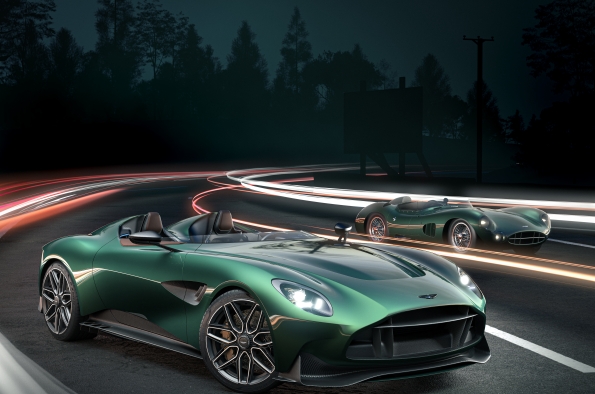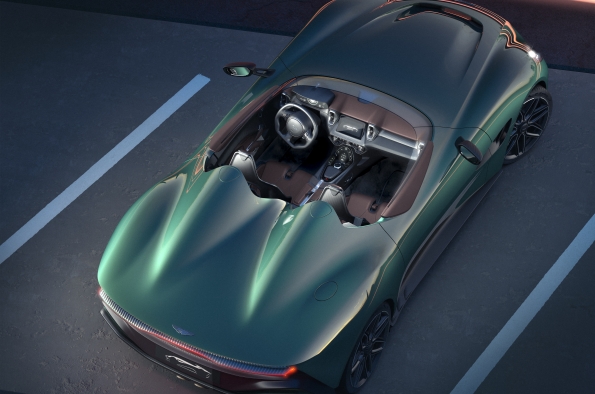British luxury sports car manufacturer Aston Martin has introduced a new roadster featuring a unique Divergent Technologies-3D printed rear assembly.
At the rear of its 705-hp DBR22 two-seater, Aston Martin is said to have integrated a support structure composed of multiple 3D printed aluminum parts bonded together, in a way that yields a significant weight saving. The subframe is built by Divergent Technologies, manufacturer of the 3D printed Czinger 21C hypercar and a supplier of major OEMs whose clients had until now, been shrouded in secrecy.
“Very excited to see some of our OEM programs come into the public light,” Czinger Vehicles Co-founder Lukas Czinger said on Linkedin. “The Divergent team has had the great pleasure of working with on of the world’s great brands, Aston Martin Lagonda Ltd, on existing and next generation production performance vehicles.”

Divergent Technologies’ ‘DAPS’ system
Divergent’s business primarily revolves around its Divergent Adaptive Production System, or ‘DAPS,’ an end-to-end hardware-software assembly platform designed as an alternative to traditional automotive production processes. Thanks to its combination of 3D printing and generative design, DAPS is ‘model agnostic,’ in that it allows for the production of multiple different car models on the same machines.
As you’d imagine, considering its ability to computationally engineer, print, and assemble parts, the system also unlocks rapid iteration, while its flexible setup is said to make it more efficient and eco-friendly than current car-making methods.
To date, the highest-profile application of the technology has been the Czinger 21C, a $2 million hypercar with a 0-62 mph speed of just 1.9 seconds, developed by Divergent’s sister company Czinger Vehicles. As revealed in the Czinger 21C’s Goodwood shakedown, the vehicle features a nearly-entirely 3D printed chassis, as well as parts consolidated into 3D printed nodes, with weight savings of up to 40%.
Over the last four months, the technology behind the 21C has earned significant backing, with Divergent awarded $160 million in funding during April, before gaining access to a $80 million credit facility in July. Later this month, Czinger Vehicles is also planning to unveil a new car at the Pebble Beach auto-show. Though the nature of this beast is still unknown, it’s said to rely on DAPS for its production.
Aston Martin’s DBR22 ups AM ante
While the DBR22 is designed to serve as a showcase for cutting-edge production techniques, it’s not the first Aston Martin to feature 3D printed parts. In 2019, Aston Martin’s AM-RB 003 concept car debuted at the Geneva Motor Show, complete with 3D printed center console, amongst other lightweighted interior components.
Since then fluid power systems manufacturer Domin and Cranfield University have worked with the firm to develop a fully-fledged Aston Martin 3D printed suspension system. Built upon Domin’s patented valve technology, in which a 3D printed core containing 25 fluid galleries work in unison to transport hydraulic fluid, the system is said to provide ‘infinite’ variability in damping, while weighing just 4kg.
With its latest futuristic design concept, however, Aston Martin has now taken its application of 3D printing to the next level, by introducing a consolidated structural element into a high-performance roadster. Unveiled at Monterey Car Week, the open-cockpit, coach-built DBR22 pairs styling akin to that of the 1956 DBR1 with modern technologies, and a new V12 that propels it from 0-60 in 3.4 seconds.
When it comes to the vehicle’s rear subframe, Aston Martin says that 3D printing the system enabled it to be made lighter without reducing its stiffness, in a way that’s perfect for making elements of “ultra-low volume models, where required.” This model, according to Divergent and Czinger Vehicles CEO Kevin Czinger, could be transformational for OEMs, and he aims to roll out DAPS more widely in future.
“Divergent is proud to be working with Aston Martin Lagonda and other major global OEMs to transform the future of automotive design and engineering,” Kevin Czinger added on Linkedin. “Beginning next month and over the next few years, the Divergent team will be scaling multiple modular factories in the US and Europe to deploy DAPS.”
“We are a Tier 1 supplier to major OEM brands with volume production programs for frames and suspension systems that range from the 100s of vehicles per model annually to the tens of thousand by 2025.”

3D printing-enabled high-powered exotics
Aston Martin isn’t the only supercar manufacturer to have turned to 3D printing, and the technology continues to be used as a means of producing custom parts for high-value vehicles in low quantities. Late last year, Spyros Panopoulos Automotive revealed that it was 3D printing Chaos ultracar body panels, in a way that made them light enough to enable its less-than-two-second 0-60 speed.
The project is reminiscent of Rodin Car’s partially-3D printed ‘FZERO,’ an upcoming hypercar that’s set to feature an additive manufactured gearbox. Believed to be the first of its kind, the transmission is being built to include a hydraulically-controlled differential, which helps manage the torque generated by its 1,000 bhp engine.
At a smaller scale, the technology is also being used by the Arash Motor Company, which 3D prints end-use electric hypercar parts. Specifically, using MakerBot 3D printers, the firm has managed to produce components ranging from prototype car models to carbon motor cartridges, electric motors and high-capacity batteries.
To stay up to date with the latest 3D printing news, don’t forget to subscribe to the 3D Printing Industry newsletter or follow us on Twitter or liking our page on Facebook.
While you’re here, why not subscribe to our Youtube channel? featuring discussion, debriefs, video shorts and webinar replays.
Are you looking for a job in the additive manufacturing industry? Visit 3D Printing Jobs for a selection of roles in the industry.
Featured image shows Aston Martin’s new DBR22 roadster. Image via Aston Martin.
